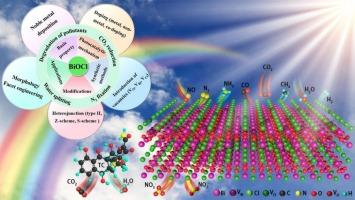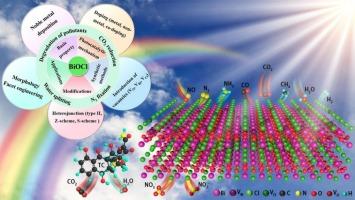Exploring the potential of BiOCl Photocatalysts in sustainable chemistry
IF 23.5
1区 化学
Q1 CHEMISTRY, INORGANIC & NUCLEAR
引用次数: 0
Abstract
As a V − VI − VII ternary structured semiconductor, bismuth oxychloride (BiOCl) and BiOCl-based photocatalysts have garnered significant attention due to their unique two-dimensional layered structures, high chemical stability, and tunable physicochemical properties. However, their further utilities in addressing energy and environmental challenges are limited by insufficient absorption spectrum, rapid carrier recombination and complex defect dynamics. To overcome these potential limitations, various approaches have been developed to improve the efficiency of BiOCl-based photocatalysts, making comprehensive reviews on this topic highly valuable. While existing reviews primarily document conventional modification strategies, this review breaks new ground by synthesizing three transformative frontiers of BiOCl, followed by an in-depth discussion of advanced modification techniques, including microstructure engineering (tailoring shapes, facets and dimensions), atomic-scale precision engineering (oxygen / metal vacancies and single-atom catalysts), elemental doping (both metal and non-metal) and heterojunction construction (type II, Z-scheme and S-scheme) establishing structure-activity relationships across emerging applications, offering new insights into the design and optimization of BiOCl-based photocatalysts. The state-of-the-arts of BiOCl-based photocatalysts are further interpreted, highlighting their versatility and promise for addressing critical energy and environmental challenges, including pollutant degradation, CO2 reduction, N2 fixation and water splitting. Additionally, this review identifies emerging trends and future opportunities in the field, such as the integration of dual-defect engineering, scalable synthesis, and computational tools for catalyst design. By addressing key challenges and proposing innovative solutions, this work bridges the gap between fundamental research and practical applications, offering a comprehensive roadmap for the rational design of next-generation BiOCl-based photocatalysts. It aims to inspire novel approaches and highlight their significant potential to accelerate the development of high-performance photocatalysts for sustainable energy conversion and environmental remediation.


探讨BiOCl光催化剂在可持续化学中的潜力
作为一种V - VI - VII三元结构半导体,氧化氯化铋(BiOCl)和BiOCl基光催化剂因其独特的二维层状结构、高化学稳定性和可调的物理化学性质而受到广泛关注。然而,它们在解决能源和环境挑战方面的进一步应用受到吸收光谱不足、快速载流子重组和复杂缺陷动力学的限制。为了克服这些潜在的局限性,人们开发了各种方法来提高biocl基光催化剂的效率,因此对这一主题进行全面的综述是非常有价值的。虽然现有的综述主要记录了传统的改性策略,但本综述通过综合BiOCl的三个变革前沿开辟了新的领域,随后深入讨论了先进的改性技术,包括微观结构工程(定制形状,切面和尺寸),原子尺度精密工程(氧/金属空位和单原子催化剂),元素掺杂(金属和非金属)和异质结构建(II型,Z-scheme和S-scheme)在新兴应用中建立了结构-活性关系,为基于biocl的光催化剂的设计和优化提供了新的见解。biocl基光催化剂的最新技术得到了进一步的解释,强调了它们的多功能性,并有望解决关键的能源和环境挑战,包括污染物降解、二氧化碳减排、N2固定和水分解。此外,本综述还指出了该领域的新兴趋势和未来机遇,例如双缺陷工程、可扩展合成和催化剂设计计算工具的集成。通过解决关键挑战和提出创新的解决方案,这项工作弥合了基础研究和实际应用之间的差距,为下一代基于biocl的光催化剂的合理设计提供了全面的路线图。它的目的是激发新的方法,并强调其巨大的潜力,以加速高性能光催化剂的可持续能源转化和环境修复的发展。
本文章由计算机程序翻译,如有差异,请以英文原文为准。
求助全文
约1分钟内获得全文
求助全文
来源期刊

Coordination Chemistry Reviews
化学-无机化学与核化学
CiteScore
34.30
自引率
5.30%
发文量
457
审稿时长
54 days
期刊介绍:
Coordination Chemistry Reviews offers rapid publication of review articles on current and significant topics in coordination chemistry, encompassing organometallic, supramolecular, theoretical, and bioinorganic chemistry. It also covers catalysis, materials chemistry, and metal-organic frameworks from a coordination chemistry perspective. Reviews summarize recent developments or discuss specific techniques, welcoming contributions from both established and emerging researchers.
The journal releases special issues on timely subjects, including those featuring contributions from specific regions or conferences. Occasional full-length book articles are also featured. Additionally, special volumes cover annual reviews of main group chemistry, transition metal group chemistry, and organometallic chemistry. These comprehensive reviews are vital resources for those engaged in coordination chemistry, further establishing Coordination Chemistry Reviews as a hub for insightful surveys in inorganic and physical inorganic chemistry.
 求助内容:
求助内容: 应助结果提醒方式:
应助结果提醒方式:


